Posted by Elena del Valle on October 24, 2014
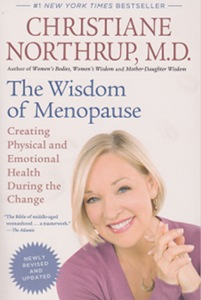
The Wisdom of Menopause
For 25 years Christiane Northrup, M.D. was a practicing physician in obstetrics and gynecology, identifying issues and treatments for patients. Now she dedicates “the second half of my life to illuminating all that can go right.” Her efforts may be welcome by many among the 48 million women in the United States in midlife, undergoing perimenopause or menopause.
She believes menopause is “a mind/body revolution, which brings tremendous opportunity for happiness” instead of the often described problem phase of women’s aging packed with a collection of symptoms to be fixed. In 1994, she shared her views in Women’s Bodies, Women’s Wisdom, her first book which went on to become a New York Times Best Seller.
In Women’s Bodies, Women’s Wisdom Creating Physical and Emotional Health During the Change (Bantam Books, $22), also a New York Times Best Seller with 1.25 million copies sold in 16 languages, she discuses her conviction that many physical ailments are born from lifestyle choices and emotional concerns. The 745-page book, most recently updated in 2012, is divided into 14 chapters in which she discusses topics such as the brain, breast health, hormones, pelvic health, food and supplements, healthy bones, sex and sleep, and heart health.
In the book, she indicates menopause leads to a new stage filled with changes, both physical and emotional. They are not, as thought in the past century, a sign of inevitable aging and decline. Instead, they lead to a woman’s transformation, and a time when she must examine her life closely and choose who she wishes to be all over again. She points to a 1998 Gallup survey at the North American Menopause Society in which more than half of respondents between 50 and 65 indicated they were living the happiest time in their lives.
She is convinced that as women go through their midlife adjustments they are drawn less to a traditional supportive family role and more to new adventures and pursuits outside of their home life. That is in contrast to men in the same age group, the author says, because they in turn seek fulfillment in relationships more than in their work, a reversal of their approach in previous years.
According to her website, Northrup has more than 4.4 million books in print, in 24 languages. Her book Mother-Daughter Wisdom was voted Amazon’s top book of the year in parenting and mind/body health.
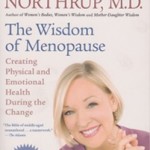
Click to buy The Wisdom of Menopause (Revised Edition)
Comments:
Filed Under: Books
Posted by Elena del Valle on October 17, 2014
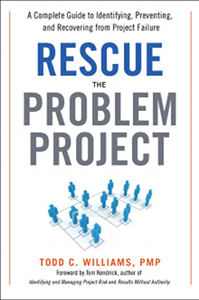
Rescue the Problem Project
Photos: Visibility Strategist
For years Todd C. Williams was the informal go to person when a problem project needed attention. He would discuss the project issues with the team in charge and pass his ideas back to the decision makers. They would in turn review them and eventually, if he succeeded in convincing them, approve them. In time, he fine tuned his process and went up the ranks. Now he is president and executive consultant at eCameron, Inc., a project rescue company based in the state of Washington.
In his book, Rescue the Problem Project: A Complete Guide to Identifying, Preventing, and Recovering from Project Failure (AMACOM, $39.95), he explains how he and his team identify a problem project, and how they recover it before it fails or has to be canceled. He shares with readers his process for rescuing red projects that focuses on root cause correction and prevention. He points out that 65 percent of projects fail to meet their goals and 25 percent of projects require cancellation.

Todd C. Williams, author, Rescue the Problem Project
The 277-page hardcover book published in 2011 is divided into twenty chapters and six main parts: Understanding the Process and Realizing a Problem Exists, Auditing the Project: Understanding the Issues, Analyzing the Data: Planning for Project Recovery, Negotiating a Solution: Proposing Workable Resolutions, Executing the New Plan: Implementing the Solutions, and Doing It Right the First Time: Avoiding Problems That Lead to Red Projects. He relies on case studies, mostly from manufacturing and information technology projects, to illustrate his steps and process. The end of each chapter includes a summary or Chapter Takeaway.
In the book, he identifies aspects he relies on in his problem solving: the team holds the answers, a strong team can solve most problems, remaining involved with the team is essential, and it is important to remain involved with the team in order to resolve the situation. He also describes his recovery process steps: realizing there’s a problem, figuring out what the problem is, identifying the causes for the problem and the possible solution, negotiating a solution everyone can agree on, and implementing the steps to solve the problem. He points out that it is essential for management to recognize that there is a problem before any of the other steps can be taken and the project rescued.
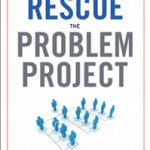
Click to buy Rescue the Problem Project
Comments:
Filed Under: Books
Posted by Elena del Valle on October 9, 2014
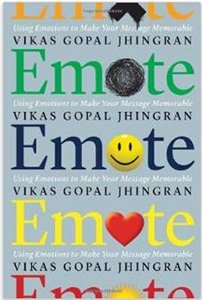
Emote
Photos: Career Press
As manager of a team of engineers at Shell Oil Company Vikas Gopal Jhingran, a Massachusetts Institute of Technology-trained engineer and researcher with a Ph.D., had demonstrated his engineering competence frequently, he says; but when it came to client presentation he was out of his comfort zone. A combination of his introverted personality and his immigrant status made public speaking a challenge hard to overcome until he determined to apply himself to improve his verbal communication skills.
By 2007 he became Toastmasters International World Champion of Public Speaking, and the second person of Asian origin to achieve such a distinction. In Emote: Using Emotions to Make Your Message Memorable (Career Press, $15.99), a 223-page softcover book published this year, he shares the insights he gleaned from his personal journey with others, especially introverts and immigrants like himself.
The book is divided into fifteen chapters, an Introduction and an Epilogue spread into three main sections: The Fundamentals, The Mechanics of Speaking, and Other Benefits of Good Communication Skills. The author shares, among other insights and ideas, his experience, emotion based approach and the speeches that led to his public speaking win in 2007.

Vikas Jhingran, author, Emote
One of the speeches was about his decision, while living in Texas, to have his mother in India arrange his marriage for him. The second speech was born of a feeling within him that he was not living life to the fullest and his desire to inspire the audience to live life for the moment. The idea behind the speeches was to make his point by moving the audience. Connecting at an emotional level with the audience, he believes, is the secret to his success.
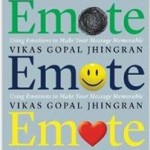
Click to buy Emote
Comments:
Filed Under: Books
Posted by Elena del Valle on September 30, 2014
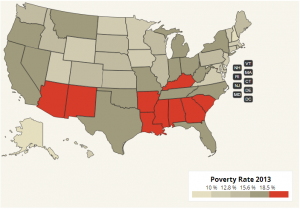
Talkpoverty Map – click to enlarge
Map: TalkPoverty.org
Rising stocks lifted household wealth 1.7 percent, according to the Federal Reserve, to $81.5 trillion between April and June of this year (see Household Net Worth Has Rebounded, The New York Times September 19, 2014 and Americans’ net worth climbs to record high, Associated Press, September 18, 2014). The numbers don’t account for inflation. They were adjusted for the change in the Consumer Price Index.
Household wealth reached a record high, 4 percent above the 2007 figures. The improvement in household wealth is especially evident among the wealthiest households. While the net worth of some Americans reached a record high poverty remains elevated, and there was an increase in new debt, mostly from auto and student loans.
Using data released by the U.S. Census Bureau, TalkPoverty.org, a project of the Center for American Progress’s Half in Ten Education Fund, recently released an interactive state by state map with congressional district level poverty data for 2013 designed to showcase the impact of poverty across the nation. It can be found at http://talkpoverty.org/poverty/
The tool relies on seven key indicators: the total poverty rate; the women in poverty rate; the child poverty rate; and the poverty rate among African Americans, Asian Americans, Native Americans, and Latinos. It also includes a ranking of states’ total poverty rates and child poverty rates.
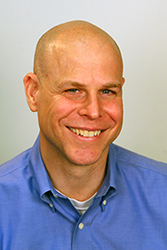
Greg Kaufmann, editor, Talkpoverty.org
“We haven’t made nearly enough progress to reduce poverty nationwide, and both low- and middle-income families are still struggling to recover from the Great Recession,” said Greg Kaufmann, editor of TalkPoverty.org and senior fellow with the Half in Ten Education Fund, in a press release. “At the state and local levels, we see the disparate impact of poverty, particularly among women and communities of color. The latest round of Census data sheds light on the reality of poverty in our own backyards, and should be a wake-up call to policymakers that we can and must do more to drastically reduce poverty.”
The Center for American Progress suggestions to reduce poverty, boost economic security, and expand the middle class include raising the minimum wage; increasing the Earned Income Tax Credit, or EITC, for childless workers; supporting equal pay; providing paid leave and paid sick days; investing in affordable, high-quality child care and early education; and expanding Medicaid.
Launched in May 2014, TalkPoverty.org is an online hub dedicated to “providing in-depth analysis and educational resources about poverty in America and what we can do at the local, state, and federal level to dramatically reduce it.”
Posted by Elena del Valle on September 24, 2014
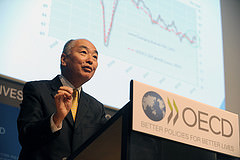
Rintaro Tamaki, deputy secretary general, OECD
Photo, graphic: OECD/Michael Dean
Most major advanced and emerging economies are experiencing a moderate if uneven expansion across regions; and growth is weak in the euro area, which may suffer prolonged stagnation unless something happens to boost demand, according to the Organisation for Economic Co-operation and Development’s (OECD) most recent Interim Economic Assessment.
In the United States, the United Kingdom and Canada, the researchers believe growth will be cause unemployment to drop. In Japan, where unemployment is already low, the economy may grow broadly. They believe China will to continue experiencing high yet more sustainable growth rates while India and Brazil rebound from the recession.
“The global economy is expanding unevenly, and at only a moderate rate,” said Rintaro Tamaki, deputy secretary general and acting chief economist, OECD, at the Interim Economic Assessment in Paris, France, according to the OECD website. “Trade growth therefore remains sluggish and labour market conditions in the main advanced economies are improving only gradually, with far too many people still unable to find good jobs worldwide. The continued failure to generate strong, balanced and inclusive growth underlines the urgency of undertaking ambitious reforms.”
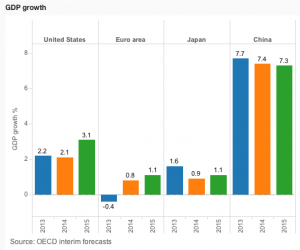
OECD Projected GDP Growth 2014-15 – click to enlarge
The OECD projects that in 2014, the United States will grow by 2.1 percent, and by 3.1 per cent in 2015; the United Kingdom will grow by 3.1 percent in 2014 and 2.8 percent in 2015; and Canada will grow 2.3 percent this year and 2.7 percent in 2015.
They estimate Japan will grow by 0.9 percent in 2014 and 1.1 percent in 2015; the euro area will grow at a 0.8 percent rate in 2014 and a 1.1 percent pace in 2015.
Growth prospects differ widely among the major euro area economies. The researchers forecast Germany will grow by 1.5 percent in 2014 and 2015, France by 0.4 percent in 2014 and 1 percent in 2015, while Italy will see a -0.4 percent drop in 2014 and a gain of just 0.1 percent in 2015.
Posted by Elena del Valle on September 19, 2014
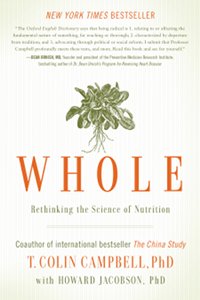
Whole: Rethinking the Science of Nutrition
Photo: BenBella Books
T. Colin Campbell, Ph.D. has spent a lifetime studying nutrition, and Howard Jacobson, Ph.D. is a health educator and ecological gardener. They believe a whole food plant based diet without added fat, salt, or refined carbohydrates (such as sugar and white flour) is the essential foundation for a healthy life. In Whole Rethinking the Science of Nutrition (BenBella Books, $16.95) they explore the evidence to support their conclusions, including their belief that people’s eating habits haven’t changed despite the availability of information about nutrition to support their arguments.
Whole follows on the heels of the publication of The China Study (see Health, nutrition experts examine comprehensive China nutrition study), a previous book authored by Campbell and his son, which addressed similar issues and conclusions about nutrition. The 328-page softcover book is divided into 19 chapters and four main parts: Enslaved by the System, Paradigm As Prison, Subtle Power and Its Wielders, and Final Thoughts.
The authors examine the concepts of whole versus reductionist biology, where whole biology views the body as more than the sum of its parts while reductionist biology focuses on the individual organs or aspects of the human anatomy. They are convinced reductionism is the primary view today and part of the reason society, medicine and social policy favor reductionist nutrition.
They propose that readers change the way they view nutrition, medicine and health, taking into account the complexity of the human body and expanding their views to encompass reductionist and wholist approaches. The reasons society clings to old reductionist approaches to eating, they say, relate to a long standing belief in the healthy nature of animal proteins, the common view that the body is made up of a set of diverse and separate parts, and a profit oriented reductionist system.

Click to buy Whole
Comments:
Filed Under: Books
Posted by Elena del Valle on September 8, 2014
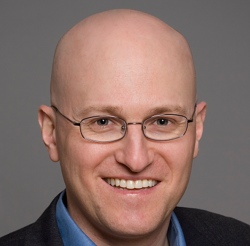
Amiel Handelsman, executive coach and author, Practice Greatness
Photo: Amiel Handelsman
A podcast interview with Amiel Handelsman, an executive coach, is available in the Podcast Section of Hispanic Marketing & Public Relations, HispanicMPR.com. During the podcast, he discusses how to practice great leadership with Elena del Valle, host of the HispanicMPR.com podcast.
Amiel, a change consultant based in Portland, Oregon, is the author of the 2014 book Practice Greatness: Escape Small Thinking, Listen Like A Master, And Lead With Your Best. He has two decades of experience helping leaders and organizations rise to the challenge of complex change.
To listen to the interview, scroll down until you see “Podcast” on the right hand side, then select “HMPR Amiel Handelsman” and click on the play button below or download the MP3 file to your iPod or MP3 player to listen on the go, in your car or at home. To download it, click on the arrow of the recording you wish to copy and save it to disk. The podcast will remain listed in the September 2014 section of the podcast archive.
Posted by Elena del Valle on August 29, 2014
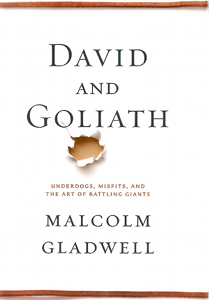
David and Goliath
Photo: Hachette Book Group
Author photo: Brooke Williams
We are impressed by size and strength, assuming giants, people or companies, should win in an encounter, according to Malcom Gladwell, a journalist and author. He believes that “much of what is beautiful and important in our world comes from adversity and struggle.”
In David and Goliath Underdogs, Misfits, and the Art of Battling Giants (Little Brown and Company, $29) he discusses how while the giants might be winners most of the time, sometimes the underdog might overcome adversity to vanquish the superpower. The 305-page hardcover book published in 2013 is divided into three main parts and nine chapters in which he explores the general theme of underdogs overcoming the odds to excel.
He explains at the beginning that facing overwhelming circumstances “produces greatness and beauty,” and that being disadvantaged in a lopsided conflict changes people, sometimes for the better. The lesson, he concludes, is that the powerful and strong are not always as we perceive them.

Malcolm Gladwell, author, David and Goliath
Throughout the book he uses examples to illustrate the points he wishes to make about how it is possible that a disadvantage such as dyslexia or loosing a parent at a young age may make people stronger than they might otherwise have been in the absence of the hardship. In other words, what doesn’t kill us might make us strong and able to beat a difficult situation to our favor.
Many American presidents and British prime ministers suffered the loss of a parent in their youth at a higher rate than the general population, he says. He points out that while such a loss is common among society’s losers it is also in evidence among its winners and wonders whether such a situation might become an advantage.
To research the chapter on the Troubles in Northern Ireland he spent a summer in Belfast. He was surprised to discover how small the areas in dispute, that had played a major role in British politics for three decades, were. Goliaths, he says, still win most of the time. The thing to remember is that they don’t win all of the time, and perhaps not nearly as often as we might expect them to.
Gladwell, a staff writer at The New Yorker since 1996, lives in New York. Prior to this book, he wrote What the Dog Saw, Outliers, Blink, and The Tipping Point.
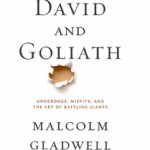
Click to buy David and Goliath
Comments:
Filed Under: Books
Posted by Elena del Valle on August 22, 2014
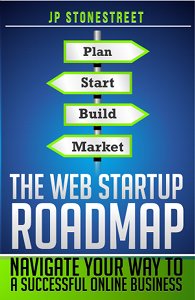
The Web Startup Roadmap
Photos: JP Stonestreet
After selling two websites in 2008, JP Stonestreet wrote The Web Startup Roadmap: Navigate Your Way to a Successful Online Business (Ripen Publishing, $22.95) to share his ideas about building an online business from scratch, marketing, running and preparing it for possible sale.
“The biggest challenge was the actual writing of the book. It’s over 300 pages! I had no idea it would be that long when I started writing it. If I had it to do over again, I’d split it up into 3 different books that are much shorter. Readers like smaller books better, too. Especially when the content is challenging,” Stonestreet said by email in response to a question about the challenge of writing the book.
An understanding of a small target audience is necessary at the beginning, he says in the book. Once your idea proves successful you can expand your audience. He lists several examples of companies that started targeting a niche audience and grew their audience over time.
When asked who his book audience is he said, “I wrote this book for non-technical people who want to start an online business or expand their current online presence but aren’t sure what to do or even where to start. The web is accessible to everyone, but understood by very few in comparison. My goal was to lift the veil and help more business owners understand how they can use it to build and grow their businesses.”
A good idea that is well developed is also necessary, as is offering something that sets you apart from competitors, he says, describing traits successful start-ups share.
In the book, he discusses business models he believes work online. The 300-page softcover book, published in 2012, is divided into five sections: Planning for Success, Starting Your Startup, Building Your Website, Marketing Your Website, and Running Your Business. In the third one he outlines his ideas about web business essentials.

JP Stonestreet, author, The Web Startup Roadmap
For him, “The biggest takeaway from publishing the book was to start promoting it before you even start writing it. After I sold my company, I wanted to document all the lessons I learned so I’d remember them. After writing pages and pages of notes, I decided to put them in a book, which led to The Web Startup Roadmap. Unfortunately, I didn’t think to promote it until it was written and published so I missed out on a lot of opportunities to raise awareness and attract press coverage. The lesson I share with everyone is to start promoting your book on social media and to your following as soon as you get the idea and the title.”
In the final two sections, he discusses marketing strategies such as affiliate marketing, advertising, social media, emails and search engine optimization; and the aspects of growing the business beyond the initial stages toward an eventual sale.
The biggest takeaway for readers? “The first section of the book discusses my long list of failures and the lessons I learned from them. If readers only take one lesson from the book, it should be the value of perseverance. Failure is inevitable if you’re a risk taker, but success is inevitable if you don’t let failure stop you from trying,” the author said.
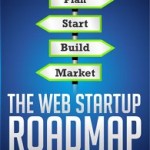
Click to buy The Web Startup Roadmap
Comments:
Filed Under: Books






























